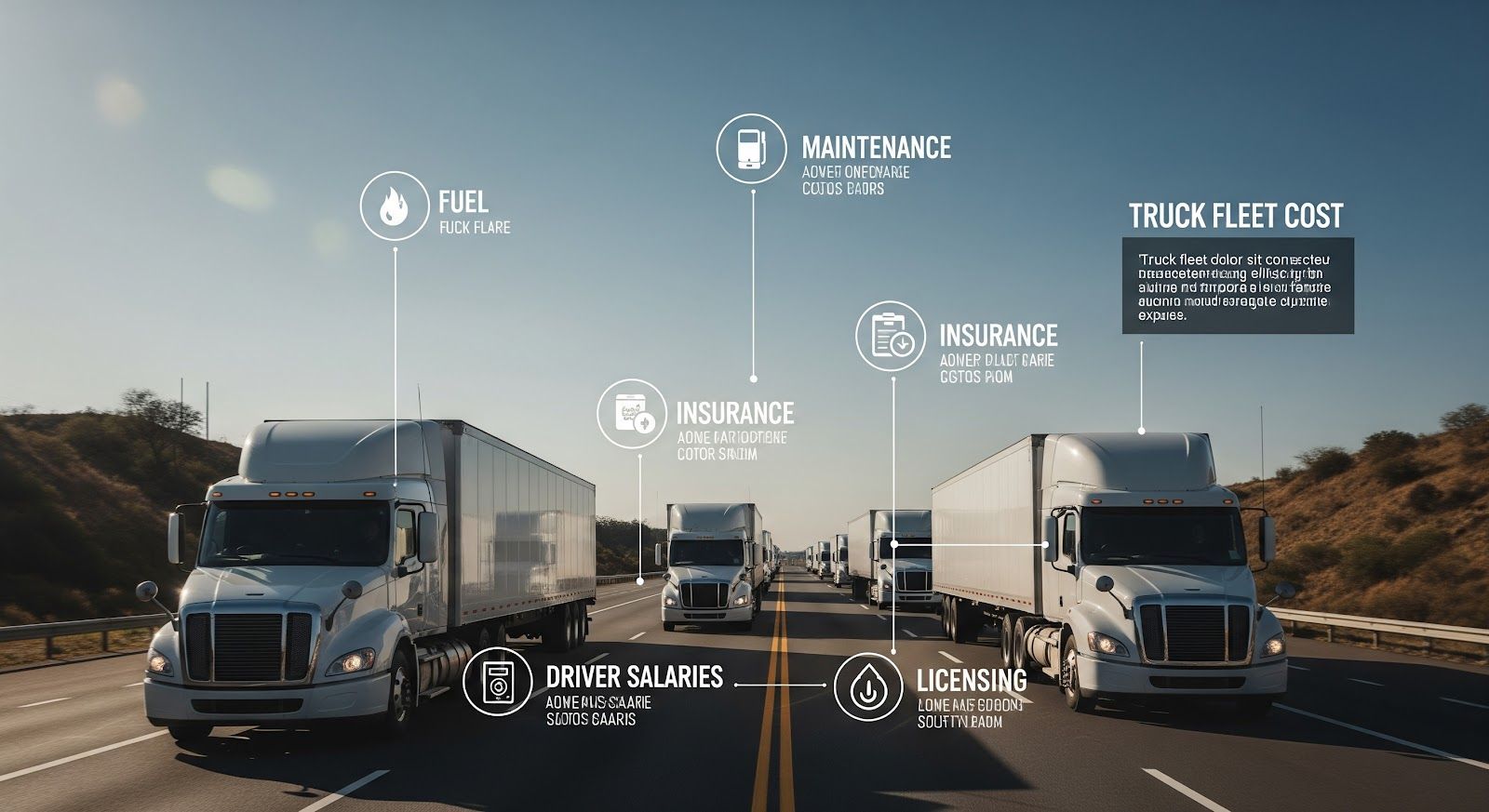6 Proven Strategies for Fleet Management Cost Savings

Whether you’re managing a long-haul trucking fleet or a regional service fleet, operating costs can quickly add up. According to industry data, fuel, maintenance, tolls, and administrative expenses can account for over 50% of total fleet operating costs. Without proper fleet cost control, businesses risk shrinking profit margins and increasing inefficiencies.
With rising fuel prices, toll road expansions, and increased regulatory requirements, many companies are seeking new ways to reduce fleet costs. Fleet cost reduction isn't just about cutting expenses-it’s about optimizing every aspect of operations to improve efficiency and reduce waste.
The good news is that businesses can achieve significant fleet cost optimization by implementing proactive measures. From consolidating toll payments to leveraging real-time reporting tools, companies that adopt modern technologies and data-driven processes can see measurable improvements in fleet cost control.
In the sections that follow, we’ll outline 6 proven strategies designed to help businesses reduce fleet costs, enhance efficiency, and improve bottom-line performance.
1. Embrace Real-Time Toll Management for Fleet Cost Reduction
One of the most overlooked areas for fleet cost reduction is toll management. For fleets operating across multiple states and toll regions, managing toll expenses manually can be complex, time-consuming, and prone to costly errors.
How Automated Toll Processing Simplifies Fleet Cost Control
Automated toll processing provides real-time visibility into toll transactions, helping businesses reduce fleet costs by eliminating paper bills, late fees, and administrative bottlenecks. With systems like Bestpass, all toll charges are consolidated into a single account, making expense tracking and reporting more efficient.
In addition to streamlining payments, real-time toll management helps fleets avoid unexpected violations and misreads, which often result in unnecessary fines. By leveraging automated toll solutions, companies gain better fleet cost control while improving operational efficiency.
Real-World Example: Fleet Cost Reduction Through Toll Consolidation
Consider the example of Deven Transport, an international fleet that operates across multiple tolling jurisdictions. Before adopting a consolidated toll management solution, they struggled with excessive fees, delayed payments, and administrative headaches.
After implementing Bestpass, Deven Transport achieved significant fleet cost reduction, saving over $13,000 per month. By consolidating toll payments and gaining access to real-time transaction data, they optimized routes, avoided violations, and drastically reduced administrative work.
Maximizing Fleet Cost Reduction with Toll Management Solutions
Solutions like Bestpass offer comprehensive toll coverage with a single, unified account, giving businesses the tools they need for maximum fleet cost optimization. Companies that consolidate toll payments often experience measurable savings, fewer violations, and streamlined processes-all of which contribute to reducing fleet costs and improving operational efficiency.
2. Optimize Routes to Reduce Fleet Costs
Route optimization is one of the fastest ways to reduce fleet costs and improve operational efficiency. Every unnecessary mile driven adds to fuel expenses, vehicle wear and tear, and toll charges, all of which negatively impact profitability.
Using GPS, Traffic Data, and Toll Insights for Fleet Cost Reduction
Modern fleet management solutions leverage GPS tracking, real-time traffic data, and toll road insights to help businesses avoid costly detours and delays. By integrating these technologies, fleet operators can identify the most efficient routes that minimize fuel consumption, reduce toll expenses, and ensure on-time deliveries.
Incorporating toll management into route planning is especially valuable for fleets operating across multiple toll regions. Understanding where toll costs can be avoided-or where time savings justify specific toll routes-plays a key role in fleet cost control.
The Critical Role of Route Planning in Fleet Cost Optimization
Route planning is not just about selecting the shortest distance-it's about balancing time, cost, and efficiency. A well-planned route considers factors like:
- Toll road expenses and potential cost-saving alternatives.
- Traffic patterns to avoid congestion that leads to fuel waste.
- Vehicle type restrictions, ensuring compliance and preventing violations.
- Delivery schedules, optimizing routes without sacrificing deadlines.
Companies that prioritize route optimization often experience measurable fleet cost reduction. With better visibility into operating conditions, businesses can reduce fleet costs by avoiding inefficient routes and unnecessary toll expenses.
How to Reduce Fleet Costs with Smarter Routing
Investing in advanced route planning tools and integrating real-time toll data enables businesses to make informed decisions that directly contribute to fleet cost optimization. Over time, consistent route efficiency translates into lower operational costs, increased productivity, and stronger bottom-line results.
3. Implement Preventive Maintenance for Fleet Cost Control
Unexpected breakdowns are one of the most expensive and disruptive challenges for fleet operators. A single vehicle out of service can lead to delivery delays, missed deadlines, and costly repairs. That’s why proactive, preventive maintenance is essential for achieving effective fleet cost control.
How Proactive Maintenance Prevents Costly Breakdowns and Reduces Fleet Costs
Preventive maintenance involves regularly scheduled inspections, servicing, and repairs to ensure vehicles stay in optimal condition. By addressing small issues before they escalate into major mechanical failures, businesses can significantly reduce fleet costs associated with emergency repairs and downtime.
A well-maintained fleet is more reliable, fuel-efficient, and less prone to unexpected expenses. This proactive approach not only improves vehicle lifespan but also contributes to overall fleet cost reduction.
Tools and Schedules to Optimize Maintenance and Reduce Fleet Costs
To maximize fleet cost optimization through preventive maintenance, companies should leverage modern tools and establish consistent schedules. Key practices include:
- Maintenance Management Software: Track service intervals, inspections, and repairs in real-time to avoid missed maintenance tasks.
- Automated Alerts: Receive notifications when vehicles are due for oil changes, brake checks, tire rotations, or other essential services.
- Data-Driven Insights: Use telematics to monitor vehicle performance and identify issues like engine faults or declining fuel efficiency early.
- Customized Schedules: Tailor maintenance schedules based on vehicle usage, mileage, and manufacturer recommendations.
Fleet Cost Control Through Preventive Maintenance
Businesses that implement structured maintenance programs experience fewer breakdowns, lower repair costs, and extended vehicle life cycles-all of which reduce fleet costs. Preventive maintenance also supports regulatory compliance and improves safety, protecting both drivers and company assets.
When combined with other fleet cost reduction strategies like route optimization and toll management, preventive maintenance becomes a key pillar of effective fleet cost control.
4. Utilize Telematics for Fleet Cost Optimization
Telematics has become a cornerstone of modern fleet management, offering powerful tools to track, monitor, and optimize vehicle and driver performance. By leveraging telematics, businesses can achieve significant fleet cost optimization and gain deeper insights into daily operations.
Monitoring Driver Behavior and Vehicle Performance to Reduce Fleet Costs
One of the key benefits of telematics is real-time driver monitoring. Poor driving habits like harsh braking, rapid acceleration, excessive idling, and speeding can directly increase fuel consumption and maintenance costs. Telematics provides the data needed to identify these behaviors and address them through coaching and training, leading to immediate fleet cost reduction.
In addition to tracking drivers, telematics systems offer continuous monitoring of vehicle health. Alerts for engine issues, low tire pressure, or other performance concerns enable fleet managers to intervene early and prevent costly breakdowns. This level of proactive fleet cost control helps extend vehicle life and improves overall efficiency.
Data-Driven Decisions That Drive Fleet Cost Reduction
Telematics systems generate actionable data that empower businesses to make smarter, cost-saving decisions. Some of the key data-driven strategies that help reduce fleet costs include:
- Optimizing Fuel Usage: Identifying fuel-wasting behaviors and inefficient routes.
- Improving Route Planning: Using real-time location and traffic data to avoid congestion.
- Scheduling Maintenance: Automating preventive maintenance based on mileage and usage patterns.
- Enhancing Driver Performance: Monitoring safety and efficiency to promote best practices.
By applying telematics insights, businesses can achieve better fleet cost control, minimize downtime, and optimize routes and vehicle utilization.
The Role of Telematics in Fleet Cost Optimization Strategies
Integrating telematics into daily operations gives fleet managers a comprehensive view of their entire fleet, enabling continuous improvement. When paired with other cost-saving measures like automated toll management and route optimization, telematics becomes an essential tool in a complete fleet cost optimization strategy.
Ultimately, using telematics is not just about tracking vehicles-it’s about transforming fleet data into measurable savings and long-term operational success.
5. Right-Size Your Fleet for Fleet Cost Control
A common but often overlooked opportunity for fleet cost control is ensuring your fleet is properly sized for your business needs. Both underutilization and overcapacity can drive up expenses, reduce efficiency, and negatively impact your bottom line. Right-sizing your fleet is a strategic way to achieve fleet cost reduction while maintaining operational effectiveness.
Avoiding Underutilization or Overcapacity to Reduce Fleet Costs
When fleets operate with more vehicles than necessary, businesses face increased expenses in the form of maintenance, insurance, and depreciation on idle or underused assets. On the other hand, having too few vehicles can result in overworked assets, costly delays, and lost revenue opportunities.
To reduce fleet costs, it's critical to strike the right balance-ensuring that each vehicle serves a clear purpose, operates efficiently, and contributes to overall fleet cost optimization.
Fleet Assessment Tips to Optimize Size and Maximize Cost Savings
Conducting regular fleet assessments is essential for optimizing size and achieving meaningful fleet cost control. Here are practical steps to guide the process:
- Analyze Utilization Rates: Track how often each vehicle is used, identifying underutilized assets that may be sold, reassigned, or eliminated.
- Evaluate Operational Demands: Review delivery schedules, route requirements, and service areas to align fleet size with actual business needs.
- Leverage Data from Telematics: Use telematics to monitor vehicle performance, mileage, and usage patterns, supporting data-driven decisions to reduce fleet costs.
- Consider Seasonal Adjustments: Flexibility in fleet size can prevent overcapacity during slower periods and ensure enough coverage during peak demand.
- Assess Vehicle Types: Optimize your fleet mix by matching the right vehicles to specific tasks, reducing unnecessary expenses tied to fuel, maintenance, and tolls.
Achieving Fleet Cost Reduction Through Right-Sizing
By implementing these fleet assessment practices, businesses can significantly reduce fleet costs, improve efficiency, and avoid hidden expenses associated with poorly optimized fleets. Right-sizing is a critical element of effective fleet cost optimization, ensuring resources are used wisely and operational costs are minimized.
When combined with other proven strategies like preventive maintenance, route optimization, and toll management, right-sizing your fleet builds a foundation for long-term fleet cost control and business success.
6. Automate Administrative Tasks to Reduce Fleet Costs
While most fleet managers focus on operational expenses like fuel and maintenance, administrative processes can quietly drain time and money if left unmanaged. Manual data entry, paperwork, and disconnected systems not only slow down operations but also contribute to hidden costs that hurt profitability. Automating administrative tasks is a powerful way to reduce fleet costs and improve efficiency across the board.
The Hidden Costs of Manual Processes
Relying on manual processes for tasks such as toll reconciliation, expense reporting, driver logs, or compliance management can lead to:
- Human Errors: Data entry mistakes, missed payments, or incorrect reports that result in financial penalties or operational delays.
- Wasted Time: Staff hours spent processing paperwork or chasing down incomplete information instead of focusing on strategic priorities.
- Reduced Visibility: Delays in accessing real-time data make it harder to maintain effective fleet cost control.
- Higher Compliance Risks: Outdated or incomplete records can lead to violations and fines, increasing overall fleet expenses.
Over time, these inefficiencies accumulate, making it harder to achieve meaningful fleet cost reduction.
Examples of Automation Tools for Fleet Cost Control
The good news is that automation solutions tailored to fleet operations can streamline processes, reduce administrative workload, and support fleet cost optimization. Some proven tools include:
- Toll Management Systems: Platforms like Bestpass automate toll payments, consolidate transactions, and provide real-time reporting, directly contributing to fleet cost reduction.
- Telematics and GPS Tracking: Automatically captures location, mileage, and driver performance data, eliminating the need for manual logs.
- Maintenance Management Software: Schedules service reminders, tracks repairs, and maintains vehicle records with minimal manual intervention.
- Fuel Management Systems: Integrates fuel cards and expense tracking to simplify fuel reporting and prevent unauthorized spending.
- Electronic Logging Devices (ELDs): Ensures regulatory compliance with automated driver hours-of-service recording, reducing paperwork and fines.
Fleet Cost Reduction Through Administrative Efficiency
Automating routine tasks frees up valuable time, reduces errors, and improves data accuracy-all of which contribute to better fleet cost control. Businesses that embrace automation not only reduce fleet costs but also gain real-time insights to make faster, more informed decisions.
When combined with other strategies like route optimization, preventive maintenance, and toll consolidation, administrative automation becomes a key driver of overall fleet cost optimization.
Case Studies Showing Measurable Fleet Cost Reduction
Many fleets have already achieved significant fleet cost savings by partnering with toll management providers like Bestpass:
- Decker Truck Line Inc.: Leveraged toll data and advanced analytics to achieve a 7% to 9% reduction in toll expenses while improving fleet efficiency.
- Deven Transport: Saved over $13,000 per month by consolidating toll payments and eliminating administrative redundancies, driving long-term fleet cost reduction.
- Werner Enterprises: Realized $200,000 in annual savings through toll discounts, violation prevention, and streamlined toll management processes.
- TransMaquila Inc.: Streamlined toll management for a 400-truck international fleet, saving hours of administrative time and reducing excess toll fees.
Smart fleet management isn’t just about moving vehicles-it’s about controlling costs, improving efficiency, and boosting profitability. Strategies like automated toll processing, optimized routes, preventive maintenance, and real-time reporting all contribute to meaningful savings.
But managing tolls manually? That’s one of the biggest hidden costs fleets face.
Ready to Take Control of Your Fleet Costs?
With Bestpass, you can simplify toll payments, reduce violations, and gain full visibility into expenses-across every major U.S. toll road.
Thousands of fleets already trust Bestpass to cut costs and streamline operations. Now it’s your turn.
Contact Bestpass today and discover how easy it is to reduce fleet costs and unlock long-term savings.

